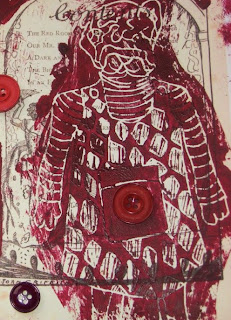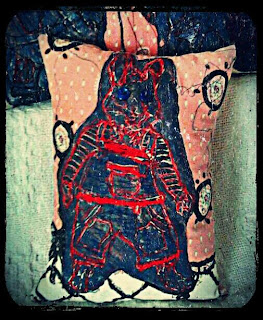 |
| Rapunzel, The Maiden in the Tower |
So, dear Readers, here I am with the next instalment of my Rapunzel-related-tale! The Maiden in the Tower is the first and best of all the Rapunzel stories, and I was pleased and relieved to come across it as I began my research. Having stated at the beginning of the project that my intention was to discover the ancient roots of the Rapunzel story, I was dismayed to read that the original story was apparently written in the 18th century by a scandalously behaved French lady named Madame de la Force! As I continued to search the wide and mysterious world of the internet however, I found that this was not the case. All that Madame de la Force did was write it down, in the same way as the Brothers Grimm, and the roots that I was looking for were not so hard to discover.
 |
| Is he a prince? Or just a personable young man? |
The main factors of the Rapunzel story can be found in many fairy tales, evil witch, beautiful girl, rescue by a prince. The first thing that makes it different is the 'Maiden in the Tower' feature, which comes under the the 'Aarne-Thompson classification 310' (I had never heard of this before, but when you put it into Google exciting things happen!). Maidens, it seems, are imprisoned in towers all over the world by those who would like to keep them and their maidenhood locked away. A lot of them have sexy long hair and an appealing habit of being amazingly witless. I liked the stories about Maid Maleen and Petrosinella, who climbed out of their towers quite unaided and made off with their men. The second linking factor is obviously the hair. The Nordic tale links come across much more strongly here, long blonde hair denotes fertility and prosperity, and similar to how the tears from Rapunzel's eyes restore the sight of the prince, the (blonde) goddess Freya is said to have wept red tears for Odin that brought him luck in battle. My favourite theory behind the legend is that the story is at heart a cycle of womanhood and fertility. This links to a piece of pagan religion but I couldn't find anyone who could tell me about this in more detail, maybe a good thing... The woman is pregnant, the baby is born, she is a little girl, the old woman is past childbearing and takes her, she tries to keep the cycle from continuing by locking her up away from men, but the girl escapes and the cycle begins again with a pregnant woman. For the modern day version, read by children, they take all the sex and violence out, yes, it is a good thing given the audience... but it makes the story unrelatable to real life.
 |
| Rapunzel linocut |
In these images, (linocuts on textured paper printed in waterbased ink), I tried to put across the wistfulness of the young Rapunzel, who is growing up but locked away from life. Also to make it evocative of an alive world, with lots of pattern, and lovely summer nights. I began with the first two images that you can see above, using watercolour and ink on paper, and then painting over with acrylic before PhotoShopping. The first two linocuts are taken from the PhotoShopped ones. I liked this particular paper because the colour reminds me of a cornfield, linking nicely in with the long blonde hair- linked to wheat and prosperity- and with the pagan fertility thing.
 |
| Prince linocut |
 |
| Blue mother linocut |
This print of Rapunzel's mother is dear to me because I love how the pose captures her wistfulness and vulnerability even though we know that she gave up her baby for some greens.
 |
| The young man linocut |
 |
| Maiden in the Tower linocut |
 |
| The witch linocut |
In this print I tried to steer the mind away from the traditional ugly-scary-witch-with-warts, as, thinking about it, the witch is rarely portrayed as an elemental, evil force of nature, and is even quite a sad, though selfish figure, keeping a little girl all to herself, forever.
 |
| Twisted forest tree linocut |
Trees! Trees and forests come up in folktales a lot. They are very, very important. They occur a lot firstly because the countries from which the stories came were often covered in trees by about 70% and would therefore be a no-brainer to include, like roads now... secondly because of what they represented. In my interpretation of the Rapunzel story I thought of the trees as being a representation of how Rapunzel is trapped in the forest. Therefore the tree above is twisty, knotted, and menacing. I printed it onto a red paper because I thought it enhanced the menace even more.
 |
| Summer tree linocut |
I put this tree on red paper as well, because it matched the one above, but the idea behind it is slightly different. The print was taken from a drawing of an elder tree, which represents young love, and summer love (according to Freya herself) and therefore I thought, quite appropriate :)
"O Lady of the Fair Hair,
Sing to me of the fair ancient land.
Yours divine voice
Whispers the poetry of magic
that flow through the wind,
Like sweet-tasting water of the Boyne.
"Girls, forever young and beautiful,
Dancing around the broken dun,
Where long forgotten heroes
sang of victory
And drank ales
to old memories.
"Sing to me one last time,
Goddess of the Fair Hair,
Before my old ear fail me.
Let me see you dance,
Before your beauty fade away
from my failing sight."
If my little excursion into this very strange world has sparked any interest in The Maiden in the Tower stories, here are some more to look at, alternatively try 'Aarne-Thompson 310' and see what surfaces!
The Maiden in the Tower: -The Canary Prince
-Rapunzel
-Petrosinella
-Beautiful Angiola
-Anthousa,Xanthousa,
Christamalousa
-Prunella
-Maid Maleen
*Those who know me please do not be alarmed by my enthusiasm for pagan influences, I'm still a christian ;)


















































